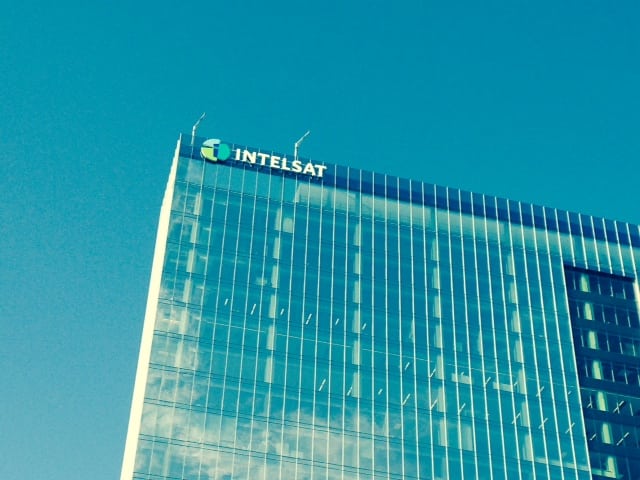Latest News

Intelsat’s McLean, Va. headquarters. Photo: Intelsat
Since Intelsat’s bankruptcy filing in May 2020, the company has portrayed its bankruptcy and restructuring as a triumphant march to continued and greater success, with an “Intelsat Onward” website and a tone of positivity. The latest development in the operator’s bankruptcy proceedings came in mid-February, when Intelsat announced that it had filed a plan of reorganization to emerge from Chapter 11 bankruptcy reorganization.
Under the plan, which Intelsat stated was supported by its largest creditors, more than half of the company’s $15 billion in debt will be erased, leaving the operator with $7 billion in debt. Most of the ownership of the company (95%) will be given to unsecured bondholders of the company’s Intelsat Jackson unit by converting their debt to equity, a recovery for them of about 8.5 cents on the dollar. Existing Intelsat shareholders will be wiped out. “New” Intelsat will also receive a $750 million secured credit facility.
Intelsat may take a positive point of view on its emergence from Chapter 11, but it’s not the only one possible. Another point of view starts with how a company with arguably the most storied history in the communications satellite sector, approximately $2 billion in annual revenues and $1 billion in EBITDA profits, incurred $15 billion in debt in the first place. That debt cost approximately $1 billion per year to service, more or less wiping out EBITDA profits. From that perspective, Intelsat’s bankruptcy is anything but a success story.
We should not ignore Intelsat’s storied history. Intelsat became operational in 1964 as an international treaty consortium of 14 countries, shortly after the 1962 Communications Satellite Act that created Comsat, the U.S. member of Intelsat, and until the 1980s enjoyed a monopoly on international satellite service. The company was privatized in 2001. In 2002, it attempted, but then withdrew, an IPO. A leveraged buyout by a private equity syndicate followed in 2004, part of a then-unprecedented wave of private equity entry into the satellite sector. The private equity exit, essentially “flipping” the company, and Intelsat’s acquisition of PanAmSat followed in 2005. Another private equity buyout that valued Intelsat at about $5 billion followed in 2008.
In each round of financial restructuring, more debt was piled on the company and more private equity investors and corporate insiders exited with large payouts. In its 2013 IPO, Intelsat originally planned an IPO of about $1.75 billion before reducing the intended capital raise to $750 million, and wound up raising $347.8 million for about 19% of the company, valuing the company at approximately $1.85 billion. During the 2004-2013 period, Intelsat also went through several rounds of non-bankruptcy debt restructurings. Coincidentally, 2004-2013 was also exactly the ten years during which I wrote the monthly Via Satellite “Dollars and Sense” column as guest contributor, and I followed the Intelsat saga closely.
The 2020 bankruptcy was at least in part prompted by the FCC’s initiative to re-designate several satellite operators’ C-band spectrum for 5G terrestrial use. The FCC has offered operators payments to accelerate their vacating the spectrum, and Intelsat dropped out of the C-Band Alliance with partners SES and Telesat to forge its own path. The company should receive nearly $5 billion in payments from the FCC for vacating the designated C-band spectrum early, money that would otherwise have gone into the U.S. Treasury.
Part of this story is the way the satellite sector has always presented itself financially, focusing on EBITDA (Earnings Before Interest, Tax, Depreciation and Amortization). Historically, the sector went through 15-year cycles of fleet replacement, and focusing on pre-depreciation earnings always made the steadily profitable, but single-digit-growth fleet operators look more profitable than they actually were.
But, as I wrote as far back as 2002, EBITDA is a meaningless financial metric for an industry in which depreciation matters so much, since satellites are a depreciating asset from the moment they are launched. EBITDA is doubly meaningless for a company with $15 billion in debt to service. It’s important to understand that Intelsat did not embark upon 18 years of financial engineering and restructuring in 2004 because it was a distressed company. The reason Intelsat loaded itself up with debt was because it was a legacy company with steady, if unspectacular, growth and reliable cash flows — an alluring financial engineering target.
I should emphasize that I do not intend to criticize the private equity and satellite and space sectors generally; I have worked in both as an attorney for over 25 years. Private equity often saves distressed companies and streamlines and rationalizes companies that are not struggling. The private equity entry into the satellite and space sector starting in 2004 brought many benefits to the sector in financial sophistication, management practices, liquidity and access to capital, among others. It enabled and financed the remarkable New Space developments in broadband, digital service, smallsats and launch services that have so transformed the industry during the same time period.
It is almost impossible to determine accurately how much shareholder equity and creditor debt has been wiped out by Intelsat’s 18 years of financial engineering culminating in the current bankruptcy restructuring and reorganization plan. It’s just as hard to accurately determine how much value has been been stripped from the company at shareholder and creditor expense by private equity sponsors and corporate insiders. At the end of this highly touted restructuring, Intelsat is still a $2 billion revenue company with $7 billion in debt instead of $15 billion, with a huge percentage of EBITDA profits still to be directed to debt service. The satellite industry should keep it in mind when considering whether this is a success story or not.
 Owen D. Kurtin is the founding member of Kurtin PLLC, a New York City-based law firm focused on corporate, commercial and regulatory representation in the Satellites & Space, Communications & Media, Information Technologies, and Private Equity sectors. Since its founding in 2008, Kurtin PLLC has represented clients in over forty countries on six continents on transactional and dispute resolution matters. For further information, please contact us at info@kurtinlaw.com.
Owen D. Kurtin is the founding member of Kurtin PLLC, a New York City-based law firm focused on corporate, commercial and regulatory representation in the Satellites & Space, Communications & Media, Information Technologies, and Private Equity sectors. Since its founding in 2008, Kurtin PLLC has represented clients in over forty countries on six continents on transactional and dispute resolution matters. For further information, please contact us at info@kurtinlaw.com.
Get the latest Via Satellite news!
Subscribe Now